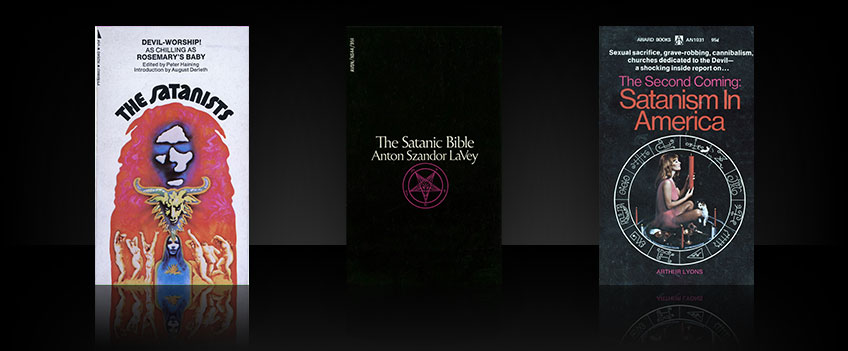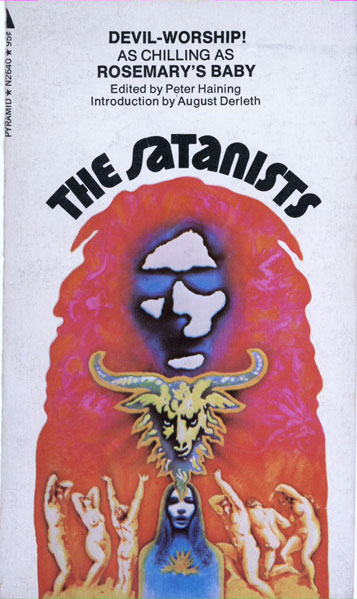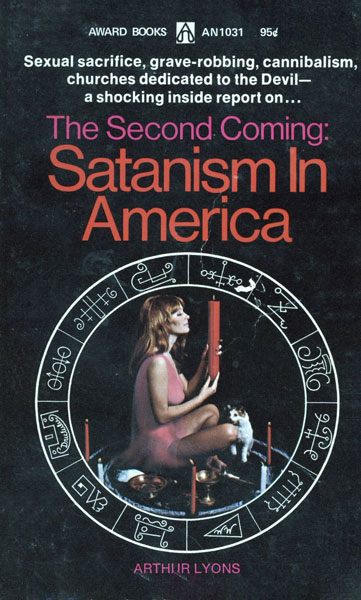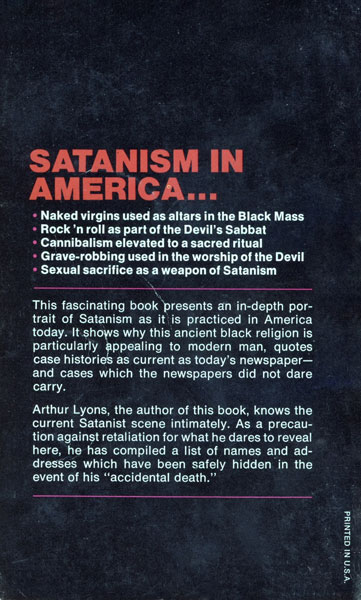

From The Archives: “Satan, The Modern Liberator,” by Deirdre LaRouche.
Guest Columnist, “Books,” St. Louis Post-Dispatch, December 27, 1970
THE SATANISTS, edited by Peter Haining, Taplinger Publishing Company, $5.95
THE SATANIC BIBLE by Anton Szandor LaVey, Avon Publishers, $.95
THE SECOND COMING: SATANISM IN AMERICA by Arthur Lyons, Dodd, Mead, $6.95
The amazing upsurge of interest in the occult arts in this country during the past few years has resulted in a flood of books on the subject. They range from the monotonous repetition of long-past ghost stories to the newer efforts of authors like Sybil Leek, Milbourne Christopher and Louise Huebner (the ladies are witches, the gentleman a magician) to prove or disprove the theories pertaining to witchcraft and other phenomena.
The three books reviewed here, however, are of a more somber and possibly frightening nature. Together, they offer a fairly comprehensive view of the satan worship-black magic-black mass syndrome which apparently is quite prevalent in our country today. Evidences of this subterranean disaffection from recognized Christian religions have been found in countries around the world, but the Satanic cults appear to be flourishing in the United States at a rate which alarms many people. The current Charles Manson trial, dealing with the Sharon Tate murders, repeatedly has been linked with black magic and Satanic practices by reports in the press.

“The Satanists” is an anthology of stories dealing with practitioners of black magic and the more malevolent forms of witchcraft. The editor, in his prologue, is admittedly horrified by the spread of “the most thoroughly evil organisation [sic]” of Satanism, an organization “dedicated to undermining the Church, outraging society, and exploring any means for corrupting the authorities and government.” The stories in this book by Lovecraft, Aleister Crowley, Dennis Wheatley, Robert Bloch and others are chosen with the avowed purpose of awakening the reader to the widespread danger and evil that lurks among us, hidden under a cloak of secrecy and protected by the fact that very few people know the true nature of the Satanic soul. The stories themselves are chillers with Bloch’s “Spawn of the Dark One” perhaps the most spine-chilling of all. It is set in contemporary America and its main characters are ultimately sacrificed to a Satan-type deity by a swarm of motorcycle-riding juvenile delinquents in a final scene that is reminiscent of the more violent parts of the movie, “The Wild Ones.”

“The Satanic Bible” by Anton LaVey approaches Satanism from a vastly different angle. LaVey is the founder and high priest of the Church of Satan, a legally functioning and licensed religion with a membership of some 7,000 people, a regular schedule of meetings and a surprisingly non-secretive attitude towards its ceremonies and teachings. The main theme of this “bible” seems to be that repression and frustration of man’s desires and needs are the underlying causes of most, if not all, of the ills that afflict society today. LaVey feels that the repressive influences of established religion, with its constant emphasis of the inherent inability of its members to meet God’s high standards of behavior and morality, are responsible for the current state of rebellion so apparent in today’s youth. How can we expect our children to conform to the mores of a society whose Christian ethic is constantly being compromised and manipulated to suit the needs, political and social, of its self-indulgent and war-oriented “older generation,” he asks. What the young people of today are seeking, LaVey feels, is an honest religion, barren of hypocrisy, martyrdom and false humility, and offering instead pride in one’s being, acknowledgement of one’s carnality and full enjoyment of all aspects of life on this Earth of ours.
Anton LaVey is, from his writing and from descriptions of him by others, a brilliant man who became thoroughly disillusioned with all so-called “good Christians” at an early age. As a carnival organist and as a San Francisco Police photographer, he saw more than he cared to of the seamier side of human nature. He developed an abiding hatred of the phrase “it was God’s will,” particularly when applied to the sufferings and deaths of innocent people who had been victims of the violence that seethes constantly under the placid and too often unconcerned eyes of our “God-fearing” citizenry.
According to LaVey, the Church of Satan does not celebrate the anti-Christian black mass, nor require of its initiates that they blaspheme, desecrate holy articles, nor subject themselves to degrading and degenerate sexual practices in order to become members. The rituals observed are not aimed at destroying other religions, but at creating in the congregation a sense of freedom of self, awareness of one’s responsibilities to self and to others, and liberation from society-imposed attitudes which hamper the full development of one’s potential as a human being. In a very real sense, the message of “The Satanic Bible” is that of Walt Whitman’s “Song of Myself” ... “I celebrate myself, and sing myself...” and I suspect that, although its existence may be deplored by many, this book and its adherents will be around for a long time to come.


Arthur Lyons’ book, “The Second Coming,” presents a well-written and carefully researched examination of Satanism in all its aspects, both past and present. Beginning with the earliest development of a “Devil” concept made concrete during the days of the Inquisition in an attempt to frighten the disaffected peasantry back into the folds of the Church — Lyons leads the reader through all the changing phases of Satan worship up to the modern day. His prime concern, aside from the historical panorama he offers, is to show clearly how wide spread the cults of Satanism are at this point in time and to offer a rational and thought-provoking explanation of their existence.
Lyons feels that the main reason for the radical groups that have sprung up throughout America recently is a growing and pervasive sense of separation of the individual from the accepted value systems of our society. Modern man, and particularly the modern American, is overwhelmed by the vastness of technological advances, the monolithic structures of government and business, the multitudes of human beings he must try to cope with [and] relate to in his daily life. His individuality must, of necessity, be secondary in importance to the overall needs of the nation, and his ability to influence the making of decisions which will, directly and indirectly, affect his personal life and happiness is virtually nonexistant [sic]. In such a situation, man’s prime need becomes the preservation of self — through identification with some group or cause that will re-establish his sense of identity, his feeling of being important, of fulfilling a useful function instead of being merely a tiny cog in a huge impersonal machine.
The worship of Satan in all its myriad forms and permutations, allows modern man to accomplish several goals at one time. He can thumb his nose at society. “He can deliberately and maliciously turn his back on all the religious values he has been taught to revere.” He can allow himself to indulge in all the thoughts and acts he has heretofore considered depraved and wicked, and he can, through these actions, convince himself that he is a daring, and therefore unique, person. In fact, his specialness is of such magnitude that it must be carefully hidden from the rest of society, lest they seek to take it from him or dilute its power by following the same path to uniqueness.
If the world is, as Lyons suggests, in the midst of its most important crisis — the old values and religions dying out, with many new cults struggling fiercely for the right to fill the powerful positions being vacated — perhaps we should examine carefully our desires for the future. Without this sort of concerned scrutiny of the emerging religions, Lyons implies, we may wake up to find ourselves crucified upside-down over a Satanic altar, while a new order of society gleefully celebrates our uncomfortable demise.
—Transcribed from the archives of the Church of Satan, April 2020.


Portrait
We Are Legion
A Moment In Time
This slideshow requires JavaScript.
SUPPORT THE
CHURCH OF SATAN!
There are many ways you can support the Church of Satan. Visit our support page to learn how.
navigation-topper



